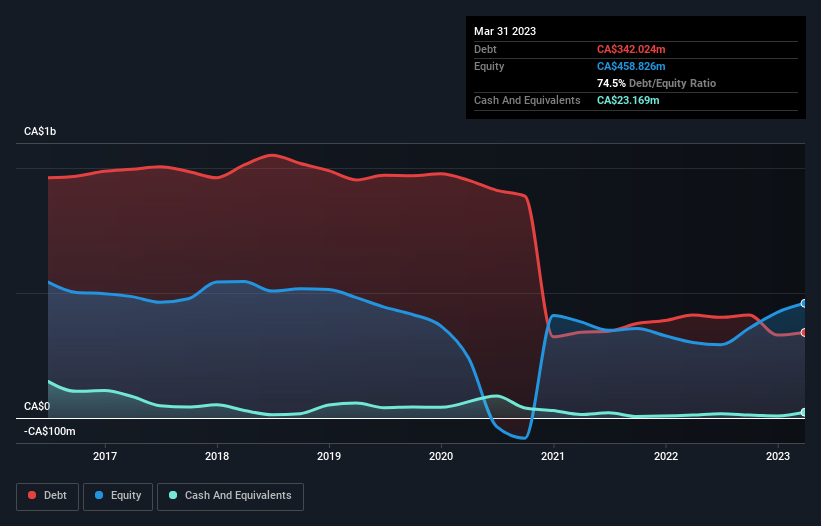Howard Marks put it nicely when he said that, rather than worrying about share price volatility, 'The possibility of permanent loss is the risk I worry about... and every practical investor I know worries about.' So it might be obvious that you need to consider debt, when you think about how risky any given stock is, because too much debt can sink a company. We note that Calfrac Well Services Ltd. (TSE:CFW) does have debt on its balance sheet. But should shareholders be worried about its use of debt?
What Risk Does Debt Bring?
Debt is a tool to help businesses grow, but if a business is incapable of paying off its lenders, then it exists at their mercy. Ultimately, if the company can't fulfill its legal obligations to repay debt, shareholders could walk away with nothing. However, a more common (but still painful) scenario is that it has to raise new equity capital at a low price, thus permanently diluting shareholders. Of course, debt can be an important tool in businesses, particularly capital heavy businesses. The first step when considering a company's debt levels is to consider its cash and debt together.
View our latest analysis for Calfrac Well Services
What Is Calfrac Well Services's Net Debt?
You can click the graphic below for the historical numbers, but it shows that Calfrac Well Services had CA$342.0m of debt in March 2023, down from CA$412.1m, one year before. On the flip side, it has CA$23.2m in cash leading to net debt of about CA$318.9m.

A Look At Calfrac Well Services' Liabilities
According to the last reported balance sheet, Calfrac Well Services had liabilities of CA$255.5m due within 12 months, and liabilities of CA$382.2m due beyond 12 months. On the other hand, it had cash of CA$23.2m and CA$314.0m worth of receivables due within a year. So its liabilities total CA$300.6m more than the combination of its cash and short-term receivables.
This deficit is considerable relative to its market capitalization of CA$349.1m, so it does suggest shareholders should keep an eye on Calfrac Well Services' use of debt. This suggests shareholders would be heavily diluted if the company needed to shore up its balance sheet in a hurry.
We use two main ratios to inform us about debt levels relative to earnings. The first is net debt divided by earnings before interest, tax, depreciation, and amortization (EBITDA), while the second is how many times its earnings before interest and tax (EBIT) covers its interest expense (or its interest cover, for short). This way, we consider both the absolute quantum of the debt, as well as the interest rates paid on it.
Looking at its net debt to EBITDA of 1.2 and interest cover of 3.4 times, it seems to us that Calfrac Well Services is probably using debt in a pretty reasonable way. But the interest payments are certainly sufficient to have us thinking about how affordable its debt is. Notably, Calfrac Well Services made a loss at the EBIT level, last year, but improved that to positive EBIT of CA$151m in the last twelve months. When analysing debt levels, the balance sheet is the obvious place to start. But ultimately the future profitability of the business will decide if Calfrac Well Services can strengthen its balance sheet over time. So if you're focused on the future you can check out this free report showing analyst profit forecasts.
Finally, a company can only pay off debt with cold hard cash, not accounting profits. So it is important to check how much of its earnings before interest and tax (EBIT) converts to actual free cash flow. In the last year, Calfrac Well Services's free cash flow amounted to 22% of its EBIT, less than we'd expect. That's not great, when it comes to paying down debt.
Our View
At the end of the day, we're far from enamoured with Calfrac Well Services's ability to cover its interest expense with its EBIT or to handle its total liabilities. But the silver lining is its relatively strong net debt to EBITDA. Once we consider all the factors above, together, it seems to us that Calfrac Well Services's debt is making it a bit risky. Some people like that sort of risk, but we're mindful of the potential pitfalls, so we'd probably prefer it carry less debt. The balance sheet is clearly the area to focus on when you are analysing debt. But ultimately, every company can contain risks that exist outside of the balance sheet. For instance, we've identified 2 warning signs for Calfrac Well Services (1 can't be ignored) you should be aware of.
When all is said and done, sometimes its easier to focus on companies that don't even need debt. Readers can access a list of growth stocks with zero net debt 100% free, right now.
New: AI Stock Screener & Alerts
Our new AI Stock Screener scans the market every day to uncover opportunities.
• Dividend Powerhouses (3%+ Yield)
• Undervalued Small Caps with Insider Buying
• High growth Tech and AI Companies
Or build your own from over 50 metrics.
Have feedback on this article? Concerned about the content? Get in touch with us directly. Alternatively, email editorial-team (at) simplywallst.com.
This article by Simply Wall St is general in nature. We provide commentary based on historical data and analyst forecasts only using an unbiased methodology and our articles are not intended to be financial advice. It does not constitute a recommendation to buy or sell any stock, and does not take account of your objectives, or your financial situation. We aim to bring you long-term focused analysis driven by fundamental data. Note that our analysis may not factor in the latest price-sensitive company announcements or qualitative material. Simply Wall St has no position in any stocks mentioned.
About TSX:CFW
Calfrac Well Services
Provides specialized oilfield services in Canada, the United States, and Argentina.
Good value with moderate growth potential.
Similar Companies
Market Insights
Community Narratives




